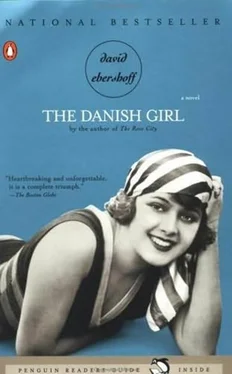And, again, this was why Einar held Henrik’s hand and ran down the back passageway with the Danish flags hanging from the burnished beams. Why he tripped in the sennep- yellow shoes Greta had first given him that April afternoon when she needed a pair of legs to paint. Why he allowed the narrow slip-dress to bind his stride: Einar was playing a game. He knew it. Greta knew it. But he also knew nothing, nothing about himself.
Outside in Rådhuspladsen, a tram clanged by, its bell friendly and sad. Three Norwegians were sitting on the rim of the fountain, laughing and drunk.
“Which way?” Henrik asked. He seemed shorter on the street, out on the open plads that smelled of the nearby cart selling coffee and spice biscuits. There was something hot in the secret pit of Einar’s stomach, and all he could do was look around at the fountain and the bronze lurblowers and the steep pitch of the roofs of the buildings surrounding the square.
“Where to?” Henrik asked again. He looked to the sky, his nostrils trembling.
Then Einar had an idea; Lili had an idea. And as strange as it might seem, it was like that: floating somewhere above Rådhuspladsen Einar watched Lili, with her determined upper lip, whisper to Henrik, “Come.” He heard her think: Greta will never know. What Lili was referring to-Greta will never know what?-Einar didn’t find out. When he, Einar, the remote owner of the borrowed body, was about to ask Lili what she was referring to; when he, Einar, floating above like a circling ghost, was about to lean in and ask-not exactly the way a driver at a fork asks himself which road to take, but almost- What won’t Greta know?, just then Lili, with her forearms flushed with heat, with chiffon in her fists, her half of the walnut brain electric with the current of thought, felt a warm trickle run from her nose to her lips.
“My God, you’re bleeding!” Henrik cried.
She brought her hand to her nose. The blood was thick, running over her mouth. The music from the Rådhuset was ringing in her nose. With each drop she felt more cleansed, empty but cleansed.
“What happened?” Henrik asked. “How did this happen?” He was yelling, and the blood seemed to run a little heavier in gratitude for his concern. “Let me get you some help.” Before she could stop him, he was running across Rådhuspladsen to some people getting into a car. He was about to tap the shoulder of a woman holding open the door. Lili watched Henrik’s finger slowly unfurl. Then she realized.
Lili tried to call “No!”-but she couldn’t speak at all. Henrik was tapping the black sturdy back of Greta, who was on the street putting Helene into the Royal Greenland Trading Company’s official car.
It was as if Greta never saw Henrik. She only saw Lili, her blood bright across Rådhuspladsen. Greta’s face tightened, and Lili thought she heard Greta whisper, “Oh no. For God ’s sake, no.” The next thing Lili knew, Greta’s blue scarf, the one Lili had been secretly borrowing, was pressed to her nose, and she was collapsing into Greta’s arms, hearing softly, like a lullaby, “Lili, are you all right? Oh, Lili, please be all right.” And then, “Did he hurt you?”
Lili shook her head.
“How did this happen?” Greta asked, her thumbs rubbing circles into Lili’s temples. Lili couldn’t say anything, could only watch Henrik, frightened of Greta, run across Rådhuspladsen, his legs long and swift, his spiraled hair swaying at the tips, the handsome slap of his foot on the cobble eerily similar to the flat punch of Einar’s father’s hand to his cheek when he discovered Einar in his grandmother’s apron as Hans’s lips pressed toward his neck.

That summer, the dealer who sold Einar’s work agreed to display ten of Greta’s paintings for two weeks. Einar arranged it, requesting the favor- My wife is becoming frustrated, he began in a letter to Herr Rasmussen-on a sheet of letterhead, though Greta wasn’t supposed to know about that. Regretfully, she unsealed the letter Einar asked her to post, using a teakettle and a fingernail-for no good reason, really, except that sometimes Greta became overwhelmed with a curiosity about her husband and what he did when he was away from her: what he was reading, where he ate his lunch, to whom he spoke and about what. It’s not because I’m jealous, Greta told herself, delicately resealing the envelope. No, it’s simply because I’m in love.
Rasmussen was bald, with Chinese-shaped eyes, a widower. He lived with his two children in an apartment near Amalienborg. When he said he ’d hang her most recent paintings, Greta was tempted to say she didn’t want his help. Then she thought about it and realized she did. To Einar she coyly said, “I’m not sure whether you spoke to Rasmussen or not. But thankfully he’s come around.”
At a furniture store on Ravnsborggade she bought ten chairs and re-tacked their cushions in red damask. The chairs she placed in front of each painting at the gallery. “For reflection,” she suggested to Rasmussen, arranging them just so. Then she wrote every European newspaper editor on the list Einar had put together over the years. The invitation announced an important debut-words Greta had trouble putting down, so boastful they seemed, so transactional, but she went ahead, at Einar’s urging. “If that’s what it takes,” she said. She hand-delivered the invitation to the offices of Berlingske Tidende , Nationaltidende , and Politiken , where a clerk in a little gray cap turned her away with a sneer.
Greta’s paintings were oversized and glossy with a shellacking process she created from varnish. They were so shiny and hard you could clean them like windows. The few critics who came to the gallery picked their way around the red damask chairs and ate the honey crackers Greta had set out in a silver dish. She escorted the critics, whose little notepads remained open and disturbingly blank. “This one is Anna Fonsmark. You know, the mezzo-soprano,” Greta would say. “The trouble I had getting her to pose!” Or, “He’s the furrier to the king. Did you notice the wreath of minks in the corner, symbolizing his trade?” When she said things like that she regretted them immediately; the crassness of her comments would ring in the air as if it were echoing off the shellacked paintings. She would think of her mother, and Greta would blush. But sometimes Greta was filled with too much immediate energy to stop and think and plan and plot. The energy was the fluid running up and down her Western spine.
She had to admit to herself that some of the critics had come only because she was Einar Wegener’s wife. “How’s Einar’s work coming along?” a few would ask. “When can we expect his next show?” One critic came because she was a Californian and he wanted to hear about the plein-air painters working there-as if Greta might know anything at all about the bearded men mixing their paints in the startling sunlight of Laguna Niguel.
The gallery on Krystalgade was cramped and, in the heat wave that coincided with her exhibition, smelled of the cheese shop next door. Greta worried that the odor of fontina would settle into her canvases, but Einar told her it was impossible, not with the shellac. “They’re impenetrable,” he remarked of her paintings, which sounded-once it was said, hovering between the two of them like a bat-unkind.
The next day, when Greta returned to the apartment, she found Lili crocheting a hair net, the needles clicking in her lap. Neither Einar nor Greta ever figured out the origins of Lili’s bloody nose at the Artists Ball. But about a month after, her nose began to bleed again, a couple of warm red bursts over the course of three days in July. Einar said it was nothing, but Greta worried, like a mother watching a son’s cough. Recently, in the middle of the night, Greta had begun to climb out of bed and go to her easel to paint an ashen Lili collapsing in Henrik’s arms. The painting was large, nearly life-size, and more real, with its bright colors and flat shapes, than Greta’s memory of Lili bleeding outside the Artists Ball. In the slanting background was the fountain with the spewing dragons, and the bronze Viking lurblowers. A frail Lili filled the painting, a man’s arms around her, his hair falling into her face. She would never forget the sight of it, Greta told herself as she painted, the climbing mix of horror and confusion and outrage still palpable on the knuckles of her spine. She knew something had changed.
Читать дальше













